TechRadar Verdict
As long as you don't mind the limited storage capacities and lack of configurability, the IdeaPad 100S is a solidly built netbook at an attractive price that comes with the power of Windows 10.
Pros
- +
Solid and thin design
- +
Good keyboard
- +
Battery life
Cons
- -
Limited storage
- -
Narrow screen viewing angle
- -
No trackpad gestures
Why you can trust TechRadar
Netbooks debuted less than a decade ago, and quickly earned a reputation for being underwhelming. Even though these machines were inexpensive, they were also incapable of many computing tasks other than basic word processing, web surfing and occasional YouTube watching.
Today, the situation is different. Although modern netbooks still carry the same inexpensive price tags, the Intel Atom processors inside enable these systems to be more powerful while coming packaged in sleeker, more attractive designs.
A case in point is Lenovo's IdeaPad 100S. Priced to take on Chromebooks, the netbook sheds all the bells and whistles found on fancier, premium-priced laptops, but still delivers a full Windows experience in a travel-friendly package.
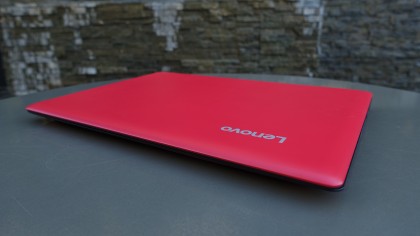
At $200 (£130, AU$277), the IdeaPad 100S faces some stiff competition. With a non-convertible, non-touch display, the IdeaPad 100S is more closely matched against Acer's Aspire One Cloudbook 11 ($152, £98, AU$210).
However, unlike netbooks of yore, Atom-equipped models today come in a variety of form factors, designs and price. Toshiba's Satellite Click 10 ($359, £232, AU$498) is more expensive, but adds a touchscreen to the Windows 10 experience.
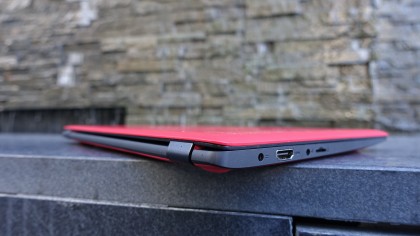
The Acer Aspire Switch 10 E ($296, £191, AU$410) offers a detachable screen, which enables users to shed the weight of the keyboard and use the device as a tablet, while the HP Stream x360 ($197, £127, AU$273) and Asus Transformer Book Flip ($279, £180, AU$387) come with a 360-degree hinge for a convertible design.
Design
Clad in a smooth, matte red plastic, the IdeaPad 100S is a playful, fun laptop, but one with which you can get some work done. Lenovo also offers the notebook in choices of white, blue or silver hues, but our review unit came with a red lid and matching red undercarriage.
I appreciated Lenovo's choice of matte finishing on the IdeaPad 100S. The red color is vibrant, but not overly bright. And unlike a glossy finish, fingerprints don't show up quite as easily. Coupled with a solid build quality, the ability of the cover to look clean after a full day of use makes the IdeaPad 100S feel more premium than it actually is.
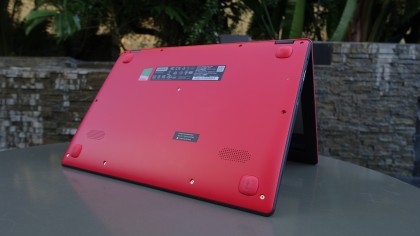
With an 11.6-inch screen, the IdeaPad 100S is just as portable as Apple's premium 11-inch MacBook Air ($899, £584, AU$1,256). Both laptops share similar footprints, but the MacBook Air ships with a more powerful processor. The IdeaPad 100S measures 11.5 x 7.95 x 0.69 inches (292 x 202 x 17.5mm), and the difference is that the aluminum-clad MacBook Air has a more dramatic tapering.
Utilizing a traditional notebook form factor, the dimensions of the IdeaPad 100S is similar to the Acer One Cloudbook, which measures 11.5 x 7.95 x 0.70 inches (292 x 201 x 17.78mm). Despite sharing a similar screen size, the HP Stream x360 has a larger footprint, likely attributed to its convertible hinge. The Stream measures 13.11 x 9.01 x 0.76 in (333.20 x 229.00 x 19.50 mm) and weighs 3.16 lbs (1.43 kg).
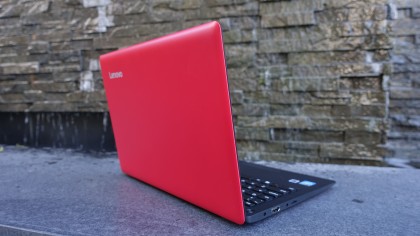
At 2.2 pounds (0.99kg), the IdeaPad weighs slightly less than the 2.54-pound (1.15kg) Acer One Cloudbook. Both these notebooks are larger than some convertibles with smaller 10-inch displays. For example, the Aspire Switch 10 E measures 10.31 x 7.09 x 1.01 inches (261.87 x 180.09 x 25.65mm) and weighs 2.82 pounds (1.28kg) with the keyboard, but comes with a smaller 10.1-inch screen.
The Intel Atom-based Celeron-powered Transformer Book comes with the same 11.6-inch screen as the IdeaPad 100S, but adds a touchscreen and a 360-degree swiveling screen in an 11.69 x 7.92 x 0.72-in (297.00 x 201.30 x 18.45 mm) form factor. The convertible design surprisingly doesn't add much weight, and the Transformer Book weighs just a little more than the IdeaPad, coming in at 2.58 pounds (1.17 kg).
Display
Opening up the lid reveals the 11.6-inch screen. Our review unit comes with a matte display. The 1,366 x 768-pixel screen resolution is the same as Apple's MacBook Air, and neither notebooks come with touch support.
This resolution is fairly standard for the netbook category, which is shared by the Transformer Book, Acer Aspire One Cloudbook and HP Stream x360. The Aspire Switch 10 E and comes with a 1,200 x 800 resolution screen on a 10.1-inch display, while the Toshiba Click 10 has a higher resolution 1,920 X 1,200-pixel screen.
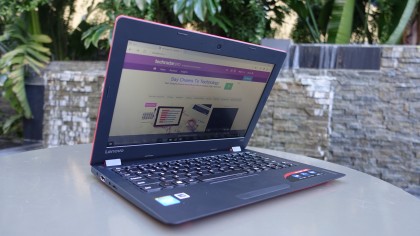
Text and graphics appear slightly pixelated on the IdeaPad 100S's screen. Using the default display settings, I didn't find text or images to be too small.
Lenovo opted to use a TN, or Twisted Nematic, panel rather than IPS. Response time on screen for watching video is good, but you likely won't want to do any serious gaming on this machine given the limitations of the Atom-class processor and integrated graphics. The downside of the TN panel, compared to more expensive IPS displays, is that viewing angles are limited.
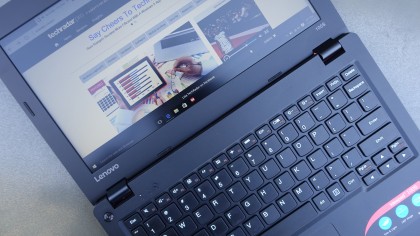
The limited viewing angles are rather unfortunate because they hinder the usefulness of the 180-degree lay-flat hinge design. If the screen came with wider viewing angles, Lenovo could have marketed the IdeaPad 100S as an inexpensive mobile collaboration devices for students and business users.
Even though the IdeaPad 100S may appeal to students or mobile professionals looking for an inexpensive second device for travel, the screen's brightness rating may limit the device for indoor use. Rated at around 200 nits, the screen brightness is lower than the 300 nits found on some premium laptops.
I didn't find any problems with the screen brightness when using the IdeaPad 100S indoors under ambient lighting, and the matte screen does a good job of reducing glare and reflections. However, outdoors under direct sunlight, the screen quickly washed out. I had better luck with screen readability outside under shade with the screen brightness cranked up.
Keyboard
Like the construction of the netbook, the keyboard on the IdeaPad 100S is solid. As is typical with Lenovo keyboard designs, the keys have a "U" or smile-shape design. Key size is slightly smaller than a full-sized keyboard on a larger ThinkPad system, and unlike the key caps on a ThinkPad keyboard, the keys on the IdeaPad are flat with a slight texture.
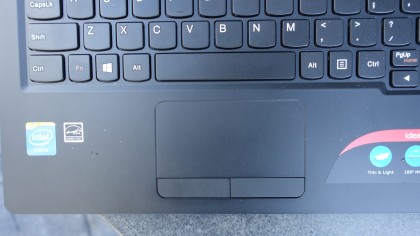
I was surprised to find that for an inexpensive laptop, the keys have a decent amount of travel when pressed. Key travel doesn't go in as deep as a full-sized laptop keyboard, but the keyboard still offered a pleasant and accurate typing experience for touch typists, which is important if you use this netbook in dimly lit environments (the IdeaPad 100S does not come with any keyboard backlighting).
A small touchpad with two clickable buttons are found just below the keyboard. The touchpad is accurate, but gestures aren't supported. You can't use two fingers to scroll nor can you call up Cortana using a three-finger tap on the touchpad.
